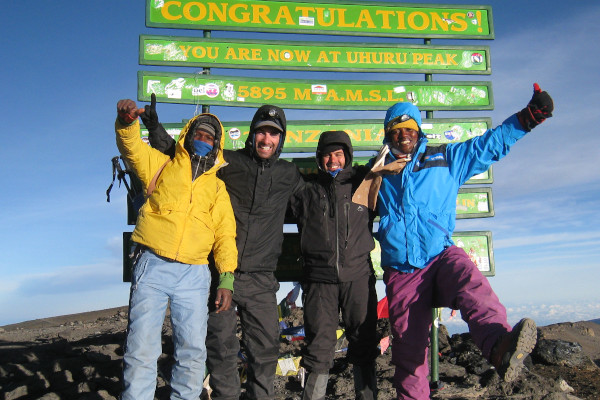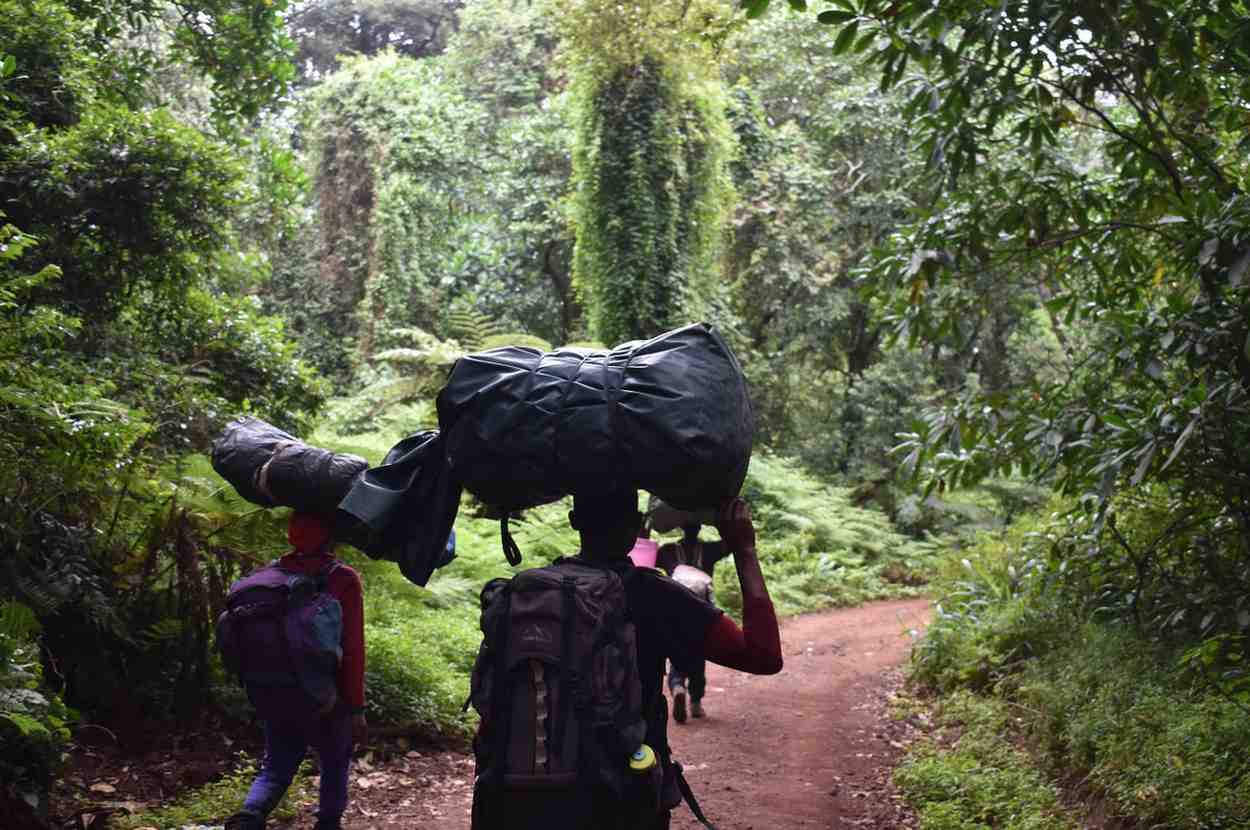There are four main Kilimanjaro Climate Zones, each with its own distinct temperature, fauna and flora. Hiking through the different zones on Kilimanjaro is part of what makes this experience unique.
Within a very short amount of time, you walk below giant ferns, pass alien-like Senecio plants and ascend slopes that could be mistaken for the surface of the moon.
The varying temperatures at these different altitudes will affect how you dress on each day of the Kilimanjaro hike.
Let's dive in to the unique biomes found on the Kilimanjaro trekking routes;
My Quick Takeaways:
Embarking on a Mount Kilimanjaro trek? Here's a brief overview of the four distinct Kilimanjaro climate zones you'll traverse:
Rainforest Zone (1,800–3,000 metres):
- Lush and Humid: Experience dense forests teeming with diverse flora and fauna.
- Warm Temperatures: Daytime highs between 21–32°C; nights can drop to 4–15°C.
- Frequent Rainfall: Be prepared for mist and occasional showers.
Low Alpine Zone (3,000–4,200 metres):
- Moorland Terrain: Transition to semi-arid grasslands and moorlands with unique plants like giant senecios.
- Cooler Climate: Daytime temperatures range from 10–27°C; nights can dip to -1°C.
- Less Humidity: Noticeably drier than the rainforest below.
High Alpine Zone (4,200–5,000 metres):
- Arid Desert: A barren landscape with sparse vegetation.
- Temperature Extremes: Days can be warm, but nights often fall below freezing.
- Intense Sunlight: High solar radiation during the day; ensure adequate sun protection.
Glacial Zone (5,000–5,895 metres):
- Arctic Conditions: Characterised by ice and snow near the summit.
- Freezing Temperatures: Both day and night temperatures are well below freezing.
- Low Oxygen Levels: Air is thin, making breathing more challenging.
Understanding these zones will help you prepare for the varying conditions you'll encounter on your journey to Kilimanjaro's summit. Now, let's take a deep dive and see what else we can learn about Kilimanjaro's climate.

Plan your Kilimanjaro trek
Get a quote from my recommended local Kilimanjaro operator
Mount Kiliimanjaro Climate Zones
The four Mt Kilimanjaro climate zones are:
- Rain forest zone (~1,800 meters – 3,000 meters)
- Low alpine zone (~3,000 meters – 4,200 meters)
- High alpine zone (~4,200 meters – 5,000 meters)
- Glacial zone (~5,000 meters to 5,895 meters)
Below we discuss each.

Rain forest zone
- Altitude range: 1,800–3,000 meters (5,900-9,800 feet)
- Day Temperature: 21-32 Celsius / 70-90 Fahrenheit
- Night Temperature: 4-15 Celsius / 40-60 Fahrenheit

The rainforest zone of Kilimanjaro is the lower parts of the mountain covered in tall, green jungle-like vegetation.
From the earliest part of your trek you are going to be confronted with tropical rain forest. Humidity is high and light mist or sometimes drizzle is common.
Various flora such as orchids, ferns, fig and olive trees cover this area of Mount Kilimanjaro.
You will likely see Blue and Colobus monkeys, and hear the calls of Turacos and tree hyrax high in the branches of the rainforest. A keen-eyed guide can sometimes point them out amongst the foilage.
If you are trekking from the North-East Rongai route or Western Lemosho, Shira or Northern Circuit you may even see elephant, buffalo and large antelope (learn more about Kilimanjaro animals).
As the temperature is fairly mild in these lower reaches, many trekkers wear shorts and t-shirts for the first day of the trek.
My Pro Tip: Don't forget to pack your rain jacket and pants as well as waterproof backpack cover into your daypack. There are often rain showers in this zone. Keep your waterproofs close to you for the entire hike.

Low alpine zone
- Altitude range: 3,000-4,200 meters (9,800-13,800 feet)
- Day Temperature: 10-27 Celsius / 50-80 Fahrenheit
- Night Temperature: (-1)-15 Celsius / 30-60 Fahrenheit
At approximately 3,000 metres the rainforest rapidly gives way to semi-arid grasslands and moorlands, this area is known as the low alpine zone.
Heather and small shrubs cover the landscape, the weather is significantly less humid and temperatures can get to sub-zero in the evening.

The giant Senecio plants on the way down to Barranco Camp look a little like aliens and stand out against the barren landscape.
The most prominent flora features in this zone are the Giant Lobelias and Dendrosenecios, which look like deformed palm trees.
Fauna is sparse; however you will likely see crows overhead foraging for food and sometimes spot a mouse scuttling between shrubs.
When the sun is out this zone is fairly warm but clouds usually roll in around midday and stay until late afternoon.
My Pro Tip: Make sure you have your down or fleece jacket with you while hiking. In the early morning you will probably want to wear gloves.

Plan your Kilimanjaro trek
Get a quote from my recommended local Kilimanjaro operator

High alpine zone
- Altitude range: 4,200-5000 meters (13,800-16,400 feet)
- Day Temperature: (-6)-15 Celsius / 20-60 Fahrenheit
- Night Temperature: (-12)-10 Celsius / 10-50 Fahrenheit
This zone is characterised by an arid desert environment that is rather inhospitable. During the day temperatures are hot and solar radiation is high (make sure to apply lots of sun-cream).
At night temperatures plummet to below freezing. From this zone the slopes of Kibo and Kilimanjaro’s summit come into perfect view.
At these altitudes, even daylight temperatures are very cold. Time to put on more layers plus your outer-shell jacket!
My Pro Tip: Remember that the sun is extra strong at this high altitude, be sure to apply sunscreen to any exposed skin.

Glacial zone
- Altitude range: 5,000-5,895 meters (16,400-19,340 feet)
- Day Temperature: (-12)-4 Celsius / 10-40 Fahrenheit
- Night Temperature: (-26)-(0) Celsius / -15-32 Fahrenheit
The final zone houses the upper reaches of Kibo and Mawenzi and consists of high altitude artic conditions. Life is very scarce in this zone as oxygen levels are near half what they were on the lower reaches of the mountain.
Fine glacial silt covers the slopes that reach up to Kilimanjaro’s summit and large glaciers are visible from Kilimanjaro’s crater rim.
Due to the high solar radiation during the day, freezing temperatures at night, gale force winds and low oxygen levels, this zone is not one where you want to stay too long!
When dressing for summit night, layering is key. Most guides recommend 5-6 layers on top (thermal, long sleeved, fleece, down and shell) and three layers on the bottom (thermal leggings, trekking pants, weatherproof outers).

Plan your Kilimanjaro trek
Get a quote from my recommended local Kilimanjaro operator
Kilimanjaro Altitude zones
Mount Kilimanjaro can be classified into three altitude zones.
- High altitude (2,500 – 3,500 metres) is the first zone you will experience. You will spend approximately 2-3 days in this zone. The onset of acute mountain sickness in this zone is low but increases as you breach the 3,000 meter mark.
- Very high altitude (3,500 – 5,500 metres) is the second zone. Typically you will spend 2-3 days in this zone as well. It is recommended you have an acclimatisation day in this zone where you climb high and sleep low. Most people experience some degree of altitude sickness in this zone.
- Extreme altitude (above 5,500 metres) is the zone you experience when you approach Kilimanjaro’s summit. You will likely only spend a few hours in this zone as you trek from the upper reaches of Kibo to Uhuru peak and back.
The onset of AMS in this zone is high, particularly if you have not given your body enough time to acclimatise in the lower zones.
Many people trekking Kilimanjaro experience mild to moderate AMS in this zone, but begin their descent before conditions escalate (see Kilimanjaro and altitude sickness).

Plan your Kilimanjaro trek
Get a quote from my recommended local Kilimanjaro operator
Mount Kilimanjaro Climate FAQ
What is the climate of Mount Kilimanjaro?
Unlike other mountain ranges which have a strong seasonal variation, Kilimanjaro's proximity to the equator means that conditions are fairly stable.
Weather patterns are determined by the altitude and time of day.
The climate on Kilimanjaro is relatively hot and humid on the lower reaches of the mountain, but varies significantly as one ascends in altitude.
Once above the cultivation zone, at around 1,800 meters, the climate on My Kilimanjaro can be split into four Kilimanjaro climate zones.
The rainforest zone between 1,800-3,000 meters, the low alpine zone between 3,000-4,200 meters, the high alpine zone between 4,200-5,000 meters and the glacial zone between 5,000-5,875 meters.
The daily and night temperatures between these zones varies a lot, from relatively temperate days (21-32 degrees Celsius) in the rainforest to freezing temperatures at night (0 to -26 degrees Celsius) near the summit.
Discover when to hike Kilimanjaro.
Is there a Kilimanjaro Climate Video?
This awesome video by Laurence Hills shows the four distinct climate zone.
My Final Thoughts
Any questions about Kilimanjaro climate zones or altitude zones? Feel free to leave a comment below and I will respond within 24 hours.
Check out some of my other handy climbing Kilimanjaro guides:


Could u please provide a description of the landscape of the volcano. If the area covered in mountains? If it is densely populated?
Thanks
Hi Riya, not sure what you mean by your question. Kilimanjaro is a dormant volcano. The structure of the mountain is freestanding. It terms of the population, no one lives on Kilimanjaro. There are two towns in the foothills of Kilimanjaro – Arusha and Moshi. Hope this helps!
Hi Please can you tell me expected temperatures in mid Jan in each Kilimanjaro zone
Hi Andrea, Check out http://www.mountain-forecast.com/peaks/Mount-Kilimanjaro/forecasts/2000 to get historical forecast of Kilimanjaro Weather by altitude.